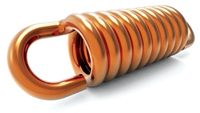
Posted to News on 21st May 2018, 00:00
Tension and compression springs: what"s the difference?
How can springs that look so similar be so different? We asked the experts at European Springs to talk us through the key differences between tension springs and compression springs.

Within the manufacturing industry, there are numerous designs and forms of spring that are used for different projects. Each spring, pressing or wire form has a specific purpose, each working differently to maximise their potential. Tension springs and compression springs look similar therefore it is understandable to confuse the two, however they are actually designed to do very different things.
The design difference between compression springs and tension springs is that the latter usually have a loop or a hook attached at either end – these are for attachment purposes. Tension springs, sometimes known as extension springs, can be found in garage doors, but a trampoline is a better example of this type of spring in action.
Pulling components together
The primary function of the tension type of spring is to allow an outside force to create tension then use energy to pull components back together. Tension springs are usually wound very tightly, and this spring is in a state of rest when it is coiled closely together. If the coils of a tension spring are damaged it will not be able to return to its original state of tension.
Tension spring applications
Tension springs can be used in a wide range of industry sectors, including rail, agriculture, oil and gas and aerospace. As tension springs can come in a diverse array of sizes, they can be used for many applications. Some of the most common uses of this type of spring include:
- Trampolines
- Automotive interior and exterior
- Garage doors
- Farm equipment
- Pliers
- Medical devices such as stretchers and surgical lights
Although compression springs are also a form of coil spring, they are designed to work differently to tension springs. Compression springs are often manufactured from a much larger gauge wire and are not wound as tightly as their tension counterparts.
The compression spring is the most common type of spring and can be found in many different products and machines such as mattresses, pogo sticks, watches, and mobile phones. The compression spring is at rest when it appears to be in an extended position and is designed to resist a compressive force.
There are many different types of compression spring. Some examples of this type of spring include:
- Conical
- Hourglass
- Barrel-shaped
- Torsional
- Magazine
Compression spring applications
Compression springs are another spring that are hugely popular and can be used within several different industries. You may not be aware, but we use these springs every day, even in some places you may not have known. Some of the most common components which use this type of spring include:
- Valves
- Locking doors
- Electrical switches
- Large stamping presses
- Railways
- Cars
- Ballpoint pens
- Compression springs
What are the main differences?
Tension springs are mainly used to hold two components together whereas compression springs are used to keep components from meeting. Both springs have a coil spring design for strength and elasticity however they are used in entirely different ways.
Compression and tension springs work in opposite ways however they are both exceptional inventions that are a necessary to many different products. They are two magnificent examples of the coil spring.
European Springs & Pressings Ltd
Lindley Moor Rd
Spring Moor
HD3 3SH
UNITED KINGDOM
01422 377335/370770








